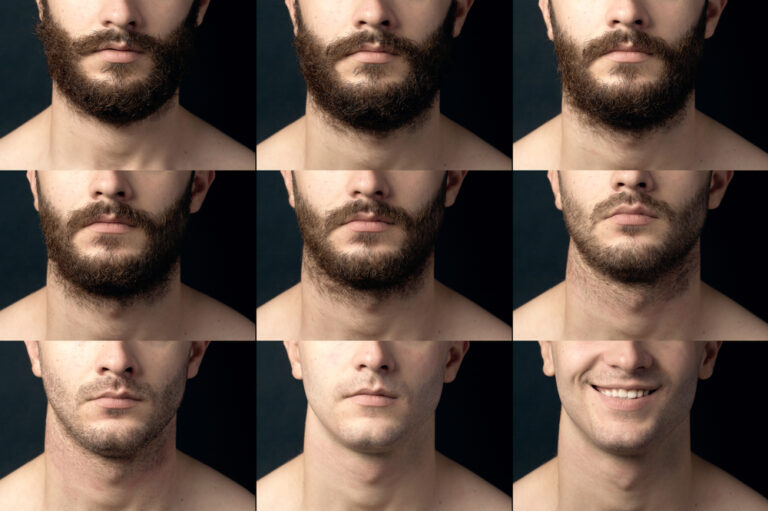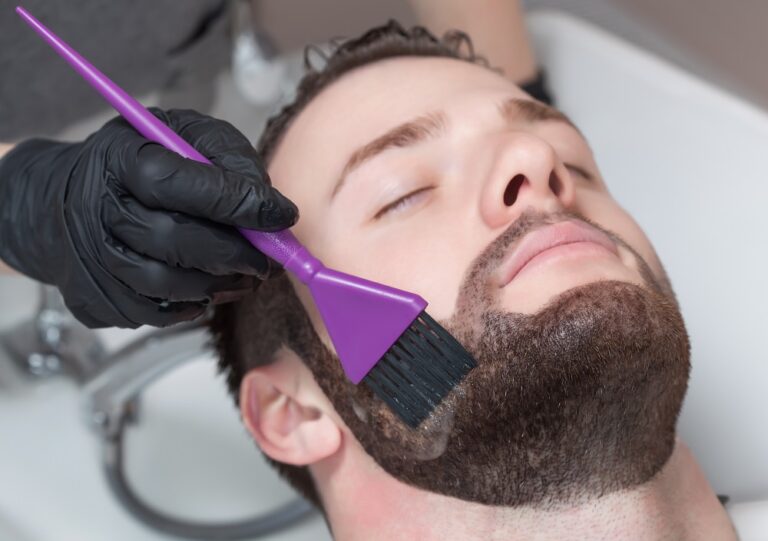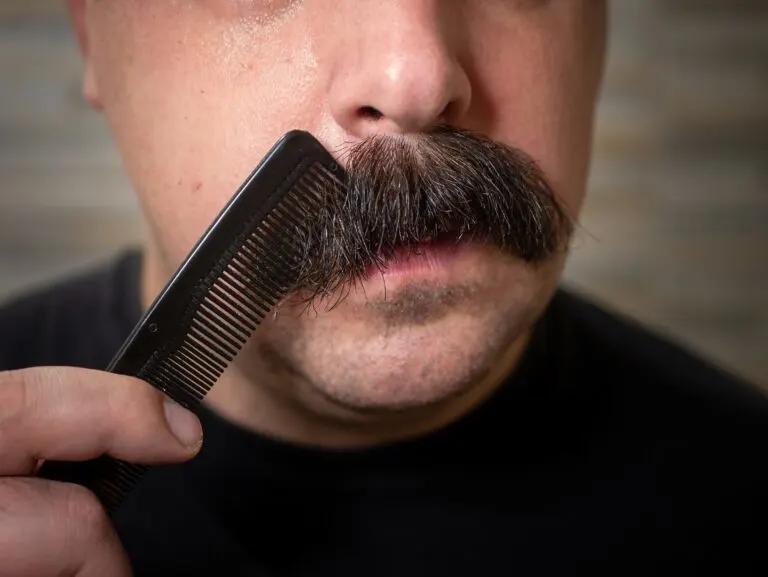How to Trim a Beard with Scissors, Trimmers, or Clippers
The key to sporting a fashionable beard lies in mastering the skill of trimming. You can maintain an eye-catching beard without stepping foot in a salon if you know the beard trimming techniques.
No matter if you’re just starting or you’re a seasoned beard aficionado, we will explore a variety of tools and methods you can utilize, such as trimming your beard with scissors, a trimmer, or a clipper.
Unlock the potential of your beard and discover newfound confidence with our comprehensive guide. Explore the benefits of a well-trimmed beard, the essential tools for the job, and a step-by-step walkthrough of the trimming process. So grab your clippers, and dive into the world of beard-trimming excellence!
The Benefits of Knowing How to Trim A Beard
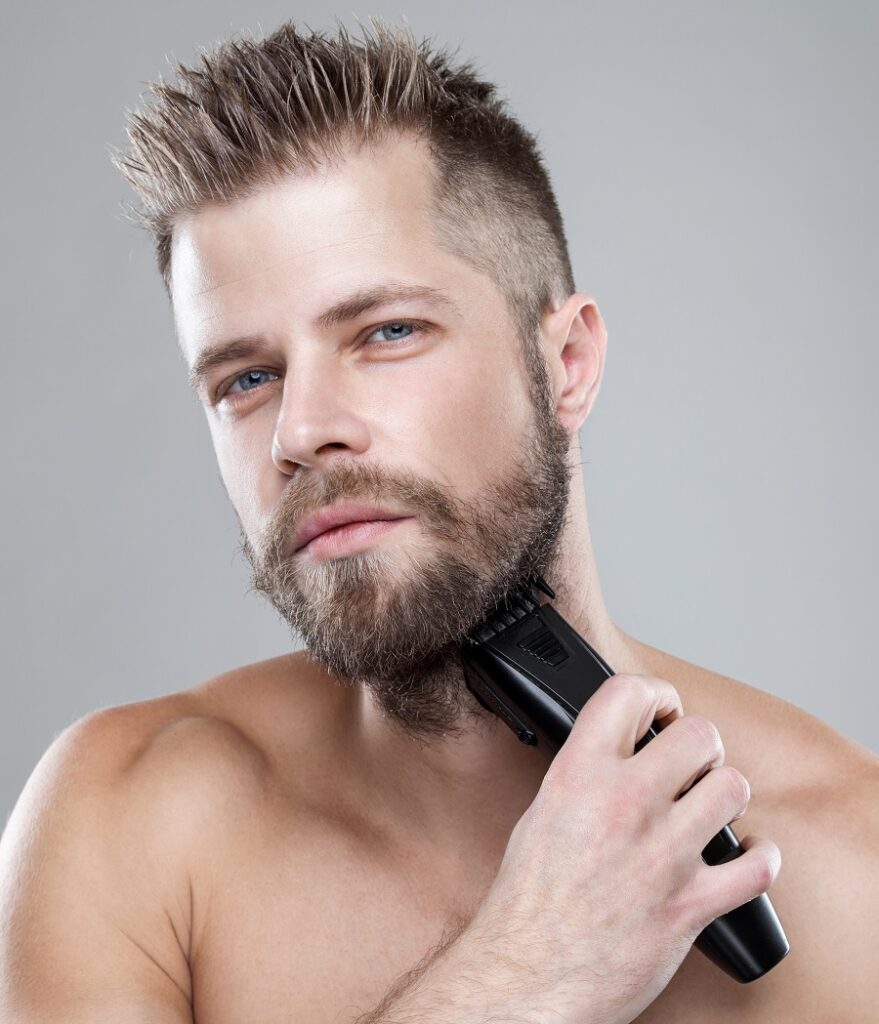
Being able to trim beards is a plus for all bearded guys. Here are some of the key benefits of knowing how to trim your beard in terms of personal grooming and overall appearance:
- Cost Savings: The main benefit of knowing how to trim is you can keep a stylish beard without spending a lot of money on regular beard maintenance trimming at the salon.
- Personalized Styling: Gain control over your beard style and length, allowing you to experiment with various looks.
- Convenience: Trim your beard at your leisure, without scheduling appointments or waiting at a barbershop.
- Improved Hygiene: Trimming a beard keeps it well-groomed. It reduces the chances of skin irritation and bacterial growth.
- Enhanced Confidence: You will feel more confident to choose challenging beard styles.
- Healthier Beard Growth: Promote strong, vibrant, and even beard growth by trimming regularly.
- Self-Sufficiency: You don’t have to worry about finding a good beard barber when you are on travel or the night before your corporate meeting.
How to Trim Your Beard: A Step-by-Step Guide
You can trim a beard by following these 6 easy steps. But the two steps require some individual research. The rest 4-steps depend on your skill.
Step 1: Get the Tools Required for Beard Trimming

Here is a list of tools for trimming a beard. You must have at least one tool from either option 1 or 2 in the list to trim your beard. Having all the tools can help you to achieve a more precise beard.
- Beard trimmer or hair clipper: A high-quality beard trimmer is essential for achieving a precise and even trim. Hair clippers are similar to beard trimmers but you can not trim your beard precisely with a hair clipper. Look for models with multiple-length settings, sharp blades, and reliable battery life.
- Scissors: They are especially useful for shaping and detailing. Avoid using dull scissors for a clean and accurate trim.
- Combs and Brushes: Necessary for trimming beard evenly. Use a wide-toothed comb for coarse, curly beards, and a fine-toothed comb for straight, finer hair. A boar bristle brush can help to distribute natural oils and keep your beard looking healthy and well-groomed.
- Razor: A manual or electric razor can be used for cleaning up the edges of your beard and creating sharp lines, particularly around the cheeks and neck.
- Beard Oil or Balm: Applying beard oil or balm after trimming can condition and moisturize your beard and protect it from damage.
Step 2: Consider Beard Styles and Length
You can not get a longer beard style by trimming your beard. So, decide on the beard style that best suits your face shape, personality, and is shorter than the existing beard length.
Short Beard Styles
If your existing beard length is medium or short or you prefer maintaining a short beard, you can choose the stubble or goatee.
Medium Beard Styles
Medium beard styles allow for more versatility in shaping and styling. The full beard and the Balbo beard are popular medium-length options. Your existing beard length before trimming must be over 6-10 cm for a medium-length beard style.
Long Beard Styles
If you want to trim your over 6-inch beard just because you don’t like the style, you can try other long styles such as the Garibaldi or the Bandholz.
Step 3: Prepare Your Beard
Clean your beard before trimming. Wash and thoroughly dry your beard. Trimming a wet beard can result in an uneven cut, as hair appears longer when wet.
After washing and drying, comb or brush your beard to remove tangles and ensure the hairs are lying in their natural direction. Now determine the amount of facial hair that needs trimming and identify areas that require shaping or special attention.
Select your desired beard length by adjusting your trimmer’s guard or using a comb as a guide for scissors. If you’re unsure about the ideal length, start with a longer setting and gradually trim it shorter until you achieve your desired look.
Step 4: Trim and Shape Your Beard
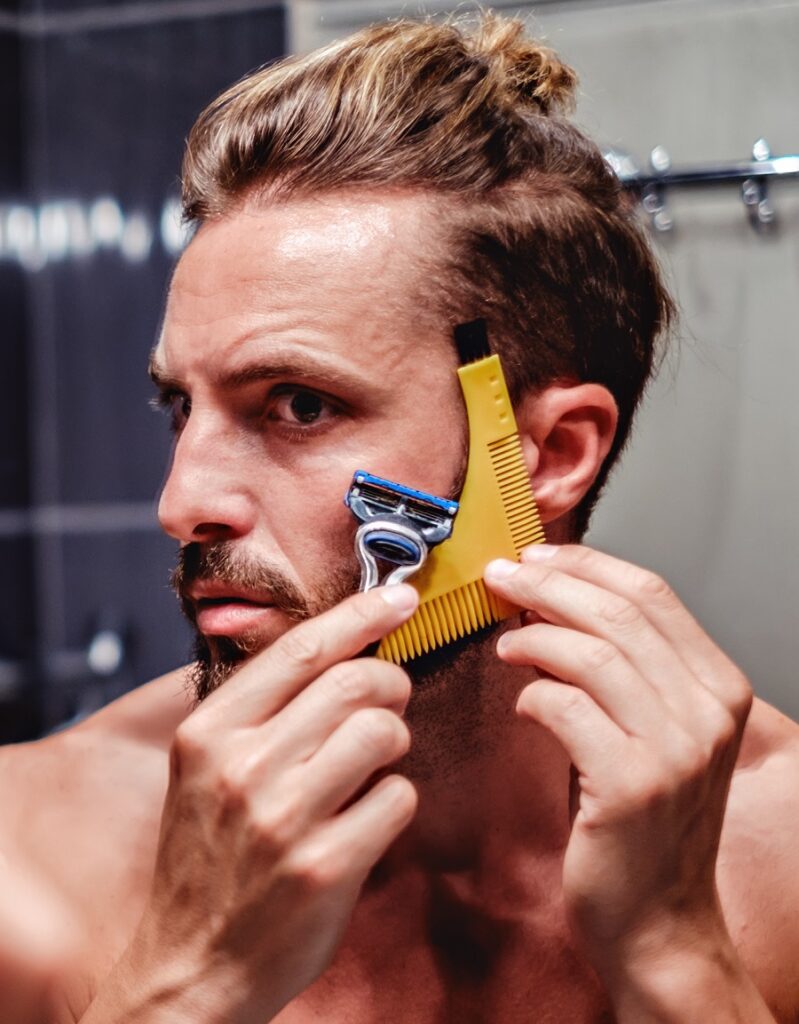
The shape of your beard is dependent on your beard style. Focus on shaping the lower part of your beard by trimming the hair around the neckline and jawline.
Work in small sections, starting at the sides and moving toward the chin. Be sure to trim both sides evenly. Check your result frequently in the mirror.
For a round beard shape, trim your beard following the natural curve of your jawline and gradually round it up towards the chin.
If you want to give your beard a square shape, instead of following the natural curve of your jawline, create a straight line from the corner of your jaw to the chin, forming a squared shape.
Step 5: Detailing the Edge
This is the difficult part. Use your trimmer without a guard/razor/scissors to define your beard’s neckline and cheek line.
To create a natural transition between your sideburns and beard, use a shorter guard on your trimmer or carefully blend the hair using scissors. This integrates the sideburns with your beard for a cohesive appearance.
Again detailing and edging depend on your beard style. For example, you can use a razor for detailing a narrow chin strap beard. But It is not recommended to use a razor while trimming a long beard.
Step 6: Moisturize and Maintain

Use beard oil or balm to avoid split ends after trimming your beard. It will also keep your beard healthy and shiny.
That’s it. You have successfully trimmed your beard. You may face difficulties in detailing the edge as a novice but gradually you will become a pro!
How to Trim with Scissors, Trimmer, or Clipper
The steps are almost similar for all trimming methods. Only tools and techniques of beard trimming are different with scissors, trimmers, and clippers. The key steps for trimming with different tools are described below.
Trimming Beard with Scissors
- Hold your sharp, high-quality hairdressing or beard scissors at a slight angle, resting your hand on your cheek for stability.
- Carefully snip away any stray hairs or uneven areas, following the natural contours and lines of your beard.
- Shape your beard by cutting the hair to your desired length and style.
Trimming Beard with Trimmer
- Choose the appropriate length setting or guard for your desired beard length.
- Use gentle, controlled strokes, following the natural growth direction of your beard.
- Shape your beard by carefully trimming around the edges and contours.
Trimming Beard with Hair Clippers
- Select the right clipper guard size for your desired beard length.
- Move the clippers downward along the beard’s natural growth direction, using smooth and steady strokes.
- Shape the beard by carefully trimming around the edges, following its natural lines.
When to Use Scissors, Trimmer, or Clipper
Your choice of grooming tool will depend on your desired beard style, length, and level of precision. Scissors offer the most control and precision, trimmers provide versatility and flexibility, and clippers are the quickest and most efficient option for uniform-length trimming. Assess your beard grooming needs and preferences to select the most suitable tool for you.
Scissors
Scissors are the go-to tool for those who want a more personalized and detailed approach to beard trimming. They offer the highest level of precision and control, making them ideal for intricate beard styles or precise adjustments. Scissors work best for:
- Detailed shaping and styling
- Personalized cuts and adjustments
- Maximum control over the trimming process
- Crafting intricate beard styles
Trimmer
A trimmer is a versatile grooming tool that’s perfect for maintaining and shaping various beard styles. With adjustable length settings and guards, trimmers allow for greater flexibility in beard length and style. Trimmers are suitable for:
- Maintaining and shaping different beard styles
- Adjusting length settings for various hair lengths
- Ensuring a consistent trim
- Regular beard maintenance and grooming
Hair Clippers
Hair clippers are basically designed for head hair. It can be also used in beard trimming for:
- Quick and consistent length trimming with less focus on detailed shaping.
- Uniform cuts with minimal fuss
- Simple beard style with fewer details
So, Use scissors when you want detailed shaping, personalized cuts, and maximum control over the cutting process, use a trimmer when you need to maintain and shape various beard styles, or use hair clippers when you want quick and consistent trim.
Comparison of Trimming Beard with Scissors, Trimmers, and Hair Clippers
| Factors | Scissors | Trimmer | Hair Clippers |
|---|---|---|---|
| Precision | High precision for detailed shaping | Moderate precision for various styles | Lower precision for uniform cuts |
| Control | Maximum control over the cutting process | Good control with adjustable settings | Less control compared to trimmer |
| Speed | Slower process for detailed grooming | Faster than scissors for trimming | Faster for quick, even cuts |
| Versatility | Most versatile for different techniques | Adjustable length settings and guards | Limited versatility for detailed cuts |
| Maintenance | Minimal maintenance required | Regular cleaning and battery management | Regular cleaning, oiling, and sharpening |
| Skill Level | Requires more skill and practice | Easier to use for beginners | Easier to use for uniform trimming |
| Suitable for | Intricate shaping and personalized cuts | Maintaining and shaping various beard styles | Quick and consistent length trimming |
How to Trim a Short Beard

A short beard style requires more frequent trimming than a long beard style. The process of trimming a short beard also requires more attention than a long or medium beard. Here is how you can trim your short beard:
- Cleanse your beard.
- Use a razor to shave the part of your beard you don’t want to keep. For example, if you are sporting a goatee, use a razor to trim your sideburns.
- Trim the chin beard with a comb and scissors. You can also use a trimmer with proper length settings.
- Do not use hair clippers for trimming a short beard.
- Clean up any stray hairs with a towel
- Moisturize your beard with shaving cream or oil.
Additional Tips for Trimming Your Beard
Regardless of the method you choose – scissors, trimmer, or hair clippers – the following tips can help you maintain your beard and keep your trimming tools in top condition:
- Patience is key: Take your time when trimming your beard. Rushing the process can result in uneven cuts or accidental removal of too much hair.
- Practice makes perfect: The more you trim your beard, the better you’ll become at understanding its growth patterns and mastering your chosen grooming tool.
- Invest in quality tools: High-quality scissors, trimmers, and clippers can make a significant difference in the ease and effectiveness of your beard grooming.
- Maintain your tools: Proper maintenance, such as cleaning, oiling, and sharpening, can prolong the life of your grooming tools and ensure optimal performance. Here is how you can maintain your tools
- Remove hair from scissors, trimmer, or clipper with a cleaning brush after use.
- Disinfect: Wipe down tools with alcohol or a disinfectant solution.
- Sharpen: Keep scissor blades sharp for precise cuts.
- Charge: Recharge trimmer batteries or replace as needed.
- Storage: Store tools in a clean, dry place to prevent damage or rust
5. Avoid over-trimming: Cutting too much hair at once can ruin the shape of your beard
6. Do not trim when the beard is wet: Trimming a wet beard can lead to over-cutting and an uneven look.
7. Prevent ingrown hairs: Trimming mistakes can lead to ingrown hairs. Avoid these mistakes to prevent ingrown hairs:
- Using a dull or old razor.
- Trimming against the grain or pulling the skin while trimming.
- Not properly preparing the skin and facial hair before trimming.
- Poor techniques, such as trimming too close to the skin or trimming too frequently.
- Not cleaning the trimming tools can lead to bacterial infections.
FAQs
1. Does trimming make a beard grow thicker?
Trimming does not make your beard grow thicker. But it can make the illusion of a thicker beard by removing split ends and promoting healthy growth.
2. How often should I trim my beard?
It depends on how fast your beard grows and how long you want it to be. As a general rule, you should trim your beard every two to three weeks.
3. Should I trim my beard with scissors or a trimmer?
Both scissors and trimmers can be used for trimming your beard. Scissors are best for precision trimming and shaping, while trimmers are better for larger areas and maintaining length.
4. Should I trim my beard if I want to grow a long beard?
To prevent split ends you should trim the ends of your beard 1-2 times in a month. But don’t trim too much if you want a long beard.
5. Can I trim a beard with a razor?
Razors are not designed for trimming. The main purpose of a razor is shaving, and using a razor on a long beard might cause a weird mustache shape.
So, you have mastered the art of trimming a beard. Now you can easily trim and maintain a dashing beard style with scissors, trimmers, or clippers, at home.


